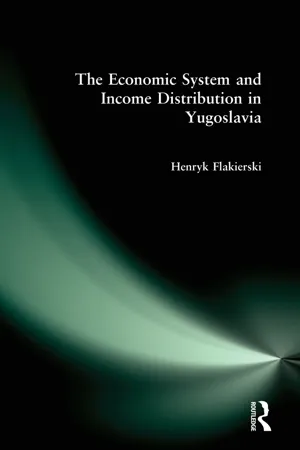
- 112 pages
- English
- ePUB (mobile friendly)
- Available on iOS & Android
The Economic System and Income Distribution in Yugoslavia
About This Book
This is the second volume in the author's ongoing inquiry into the extent of income inequality in the East European socialist countries and the effect of market-oriented reforms on patterns of income distribution. Although there has been remarkably little empirical research on this question (in part because of the problem of obtaining reliable data), both proponents and opponents of reforms voice strong views on this subject, with both sides, however, tending to grant the assumption that decentralization and the increased use of market mechanisms will increase inequality. In this study as in the preceding volume, "Economic Reform and Income Distribution: A Case Study of Hungary and Poland", Henryk Flakierski undertakes a study of the data in order to shed light on this question - this time with reference to the most decentralized of the East European economics and the one in which marketization of the economy has been most advanced.
Frequently asked questions
Notes
I. A Survey of Systemic Changes
| Manual workers = 100 | Office employees in industry = 100 | |||
|---|---|---|---|---|
| Years | Office employees in industry | Civil servants | Manual workers | Civil servants |
| 1939 | 175 | 193 | 57 | 111 |
| 1953 | 122 | 104 | 82 | 85 |
Table of contents
- Cover
- Half Title
- Title
- Copyright
- Contents
- Preface
- I. A Survey of Systemic Changes
- II. Statistical Analysis
- III. Skill Differentials and Self-Management
- IV. Interbranch Pay Differentials and Self-Management
- V. Conclusions: Is Self-Management the Villain?
- Appendix
- Notes